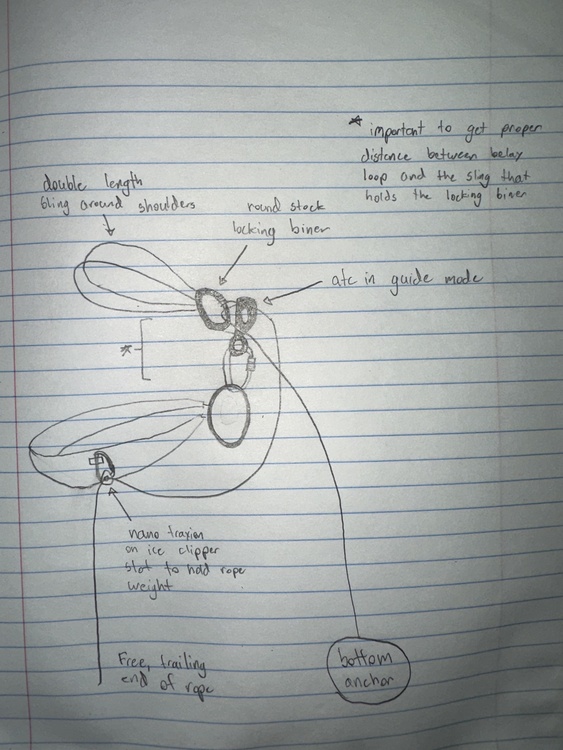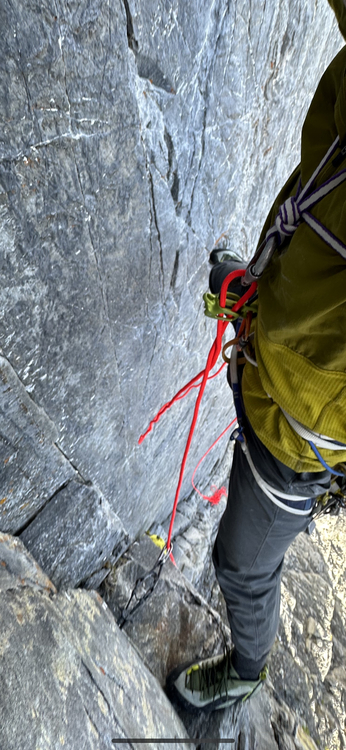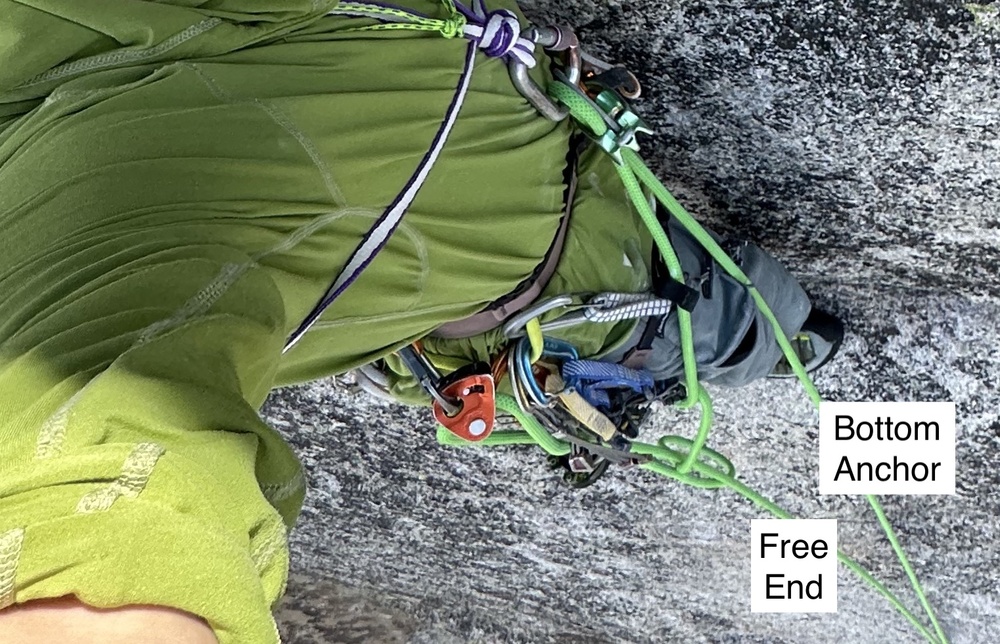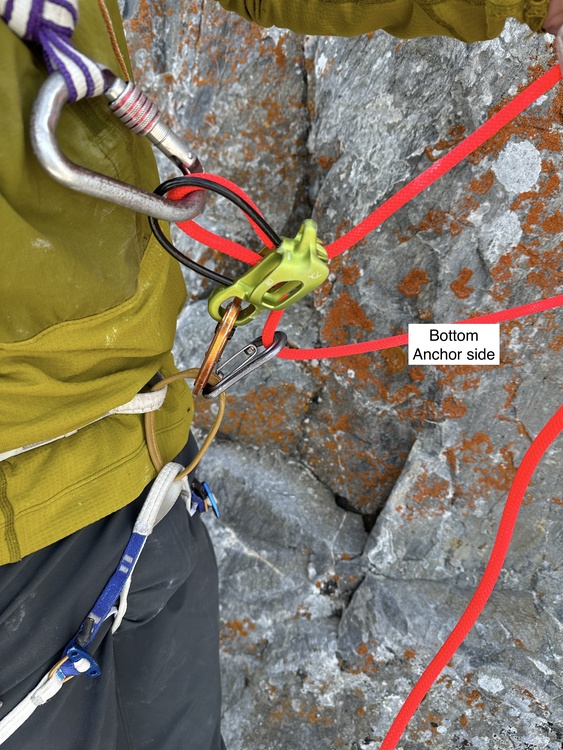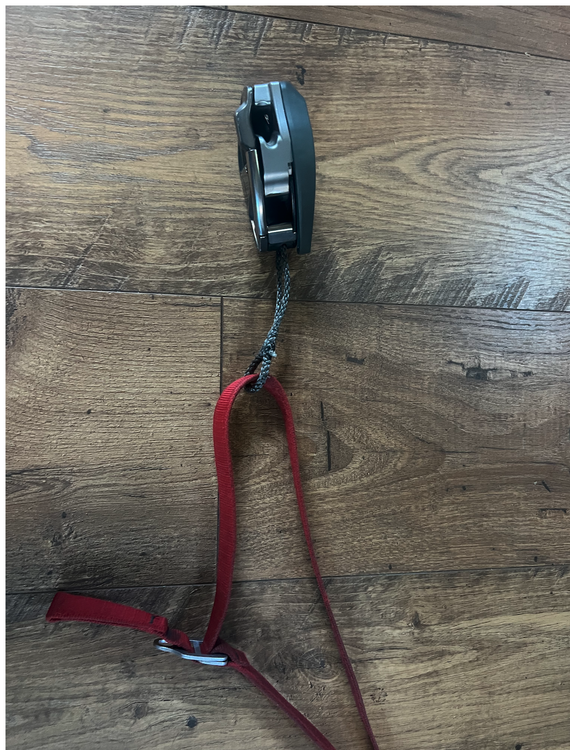"Alpine" lead rope solo system for free climbing.
|
|
I'm not claiming this is anything particularly new or innovative but I have experimented with a handful of rope solo systems and have really been liking this latest system. I find it simpler, smoother, safer, and lighter than other common rope solo systems that use a grigri, revo etc. The intention of this post is just to share some beta that others may find useful. It is assumed the reader already has some sort of familiarity with LRS systems. Rather than a mechanical device, the "ALRSS" simply uses an ATC in guide mode. I'll use the term "alpine" because the biggest advantage to this system over a GriGri is that it reliably works with any diameter rope and requires less gear. Two other significant advantages of this are that it locks faster during falls and has less failure modes than mechanical devices so I feel comfortable without any sort of back up knots or secondary attachment to the rope. Soo how is it set up? see the crude diagrams and photos below Note that the double length sling around shoulders allows much more smooth free climbing than any bunjee cord system does to support the round stock locker. Here I am using a 7.3mm beal gully with a BD atc alpine guide. (apologies for the twisted rope making the photos a little unclear) Here I am using an 8.5mm beal opera with a standard reverso. It immediately "locked" every time. I fell to my backup knot during all my falls when using this rope with a GriGri. For aid soloing I still generally prefer a grigri because I am probably using a thicker rope and have a grigri on me anyway. One disadvantage of this system is that it is harder to lower if you need to to a pendulum or something. If for some reason I want to do a short lower or rappel to grab a piece of gear or something while "on lead" I simply clip a small, non locker to my belay loop and rethread the rope through it which essentially blocks guide mode. feel free to suggest any edits to this post or system! |
|
|
Alec Baker wrote: No, but I see your point! could be worth incorporating a small zip tie or something in the connection between the shoulder sling and roundstock locker |
|
|
I’ve used this method before but didn’t like it nearly as much as a gri gri or the Revo. Also I somewhat remember reading something about the breaking strength of the guide mode being shockingly low. |
|
|
You see people play with this not infrequently since it's simple to figure out and uses gear we all have. Most don't stick with it for long. I reckon people like the functionality of the popular LRS devices. |
|
|
Bernard Amy demonstrated a nearly identical system in his book Technique de L'Alpinisme in 1977. Looks safe enough--just seems like it wouldn't be very smooth paying out rope given my experience with sore shoulders when belaying a second up in guide mode with an ATC. I've f'ed around with lead rope solo a few times and never figured out a system that worked for me though. So if this works well for you, use it! As for me, I think I'll just TR solo until someone starts making the Silent Partner at affordable prices again. |
|
|
Ik it’s a lot of words but if you guys read my post you may realize your comments are not entirely relevant. The intention is for this to be a resource, not a question. |
|
|
Bug Boy wrote: Your system has been tried many times and people should be aware of its limitations. Not trying to be a dick, but you didn't spend much time investigating why such an obvious system is unpopular. |
|
|
I believe this system is ace! However, I’m looking to find the smoothest way to lrs on an edelrid rap line. The atc alpine guide isn’t really narrow enough to prevent the ropes from accidentally crossing. It might even happen using a 7,3 mm rope. But, I don’t want to use a clove hitch . A bespoke one, optimised for 6mm would be the best but that’s probably not coming out any time soon so I’m experimenting with narrowing an existing one, glueing an aluminium plate on the inside. It look reasonable promising but wondering if anyone here have an another smooth and good setup for use on 6mm? |
|
|
Ricky Harline wrote: FWIW I have climbed over 20 pitches with this system up to mid 5.11 trad and I only onsite around .11+ consistently. Maybe it works better on routes that are steeper and less ledgy than the easier stuff you're on. But yes it has it's limitations as does every system. I would not consider this system obvious and I think that most people don't put in the time to get it tuned to the point where it works well. I mostly use a grigri+ now unless I am climbing with a rope under 8.5mm or the rope is likely to be icy. |
|
|
Bug Boy wrote: Wouldn't the number of falls you've taken on this system be more informative than the grade you're climbing with it? I mean, if you flashed those 20 pitches... |
|
|
Every time I see a post like this it just makes me more grateful I bought a Silent Partner back when they were still selling them. |
|
|
https://americanalpineclub.org/news/2024/9/11/the-prescriptionseptember?mc_cid=026ed83764 Your systems seems like it would have a similar failure mode to this accident |
|
|
Gunkiemike wrote: Good point! I think it would be similarly informative because climbing the pitches cleanly shows that it feeds smoothly enough to allow me to climb pitches cleanly. I have taken maybe 10 practice and 5 real falls on this system but not typically the type of climber to be falling regularly outside of sport of climbing and especially climbing solo and trad multi pitches. With this system more than systems that use mechanical devices I think the benefit is reliability of consistent catches and the trade off is having a hard time feeding/climbing freely so “pitches flashed” is a relevant stat. |
|
|
Bug Boy wrote: Glad it's working out well for you, man. Proud work using it so close to your normal onsight grade. Most people don't do that on any LRS system. |
|
|
Zack Smith wrote: In this accident, they also seemed to conclude that the fall created a force greater than a factor 2 fall and the carabiner was not round stock, as is bug boy’s |
|
|
Bug Boy wrote: You only consistently on-site 5.11+? |
|
|
Bug Boy wrote: This sentence had alarms ringing in my head immediately. Identifying failure modes for something as mechanically complex as a lead rope solo system being applied to the truly vast set of oddball circumstances encountered when outdoor rock climbing is a very complicated task, and you're kidding yourself if you think you've thought of everything. Throw in all the possible items of clothing and dangly things attached you and your harness and how all of those things could negatively interact with the system while falling through the air and the universe of odd failure modes compounds further. Later replies in this thread indicate you hadn't even considered an inverted fall, which is one of the most obvious special circumstances to consider. While I appreciate your desire to be a resource, I think your system as proposed with no kind of backup is foolhardy. Backup your LRS systems, kids. |
|
|
It won’t hold an inverted fall but a Grigri may not either and IMO any rope soloing system should be backed up with a solid connection to the rope and not just a traction holding your cache loop. I believe Jim Titt said testing of this system showed it to be inadequate but the proof is in the pudding, and this guy has whipped on it over a dozen times. Thanks for the real world testing! an interesting application is that you can use this system on double ropes. I can think of plenty of alpine climbs where you may need to rope solo short pitches while also having 60 m of rope to get off the climb. The system will work with the skinniest twin line you can find. And again requires hardly any extra gear. |
|
|
Sam Skovgaard wrote: Most LRS won't reliably catch inverted falls. "Less failure modes" does not equal all failure modes. I am not and never had claimed to have thought of everything. I am not overly worried about inverted falls especially for free climbing and especially for the routes and circumstances I would use this system in. Easy enough to throw a one handed back up knot in before a crux. The intended audience for this resource is not every climber. Of course it always good to question and critique posts like this so their flaws are shortcomings are clear. |
|
|
Bug boy, this is a bad ass system. Everybody seems to be a critic online but I am thankful you put this out there. I love how light and simple it is for long alpine scrambles that have a few pitches of hard climbing. I will experiment with this set up soon. |
|
|
I dont know about bad-ass, but it is a system that works. |

 Continue with onX Maps
Continue with onX Maps Sign in with Facebook
Sign in with Facebook




















